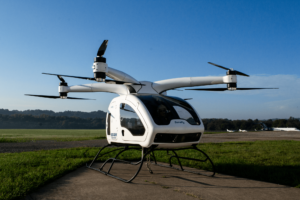From the dawn of civilization, mankind has wondered what the future would bring. From children looking up at the moon, wondering when man would get there to serious futurists, engineers and science writers, people have dreamed of what lies ahead.
Here are some of the predictions about travel and transportation in the year 2020.
We’ll have ape chauffeurs. The second issue of The Futurist magazine, published in 1967, contained an exclusive report from the RAND Corp., a global think tank with a track record that’s included contributing to the space program and the development of the internet. In a story titled “Intelligent Apes Become Chauffeurs,” they shared details from a RAND study indicating that, “by the year 2020 it may be possible to breed intelligent species of animals, such as apes, that will be capable of performing manual labor. During the 21st Century, those houses that don’t have a robot in the broom closet could have a live-in ape to do the cleaning and gardening chores.” The study concluded that “the use of well-trained apes as family chauffeurs might decrease the number of automobile accidents.”
Roads will become tubes. If you’re sick of asphalt roads, with all their potholes and endless rush-hour gridlock, then you should be delighted to learn that by 2020, every road and street in America will be “replaced by a network of pneumatic tubes.” That’s according to a 1957 article in Popular Mechanics, which explained how the family vehicle of 2020 would only need enough power to get from your home to the nearest tube. Then, by the calculations of a Honeywell engineer, “they will be pneumatically powered to any desired destination.”
We’ll live in flying houses. Arthur C. Clarke, an inventor, science writer and futurist, believed the boring houses of 1966 would be radically different by the time we reached 2020. The house of the future “would have no roots tying it to the ground,” he wrote. “Gone would be water pipes, drains, power lines; the autonomous home could therefore move, or be moved, to anywhere on Earth at the owner’s whim.” And it wasn’t just one home that could relocate without the owner even needing to get out of bed. “Whole communities may migrate south in the winter, or move to new lands whenever they feel the need for a change of scenery,” Clarke promised.
We’ll finally make it to Mars. We’ve been dreaming of making it to Mars for as long as we’ve known the red planet existed. Only recently that venture has started to feel remotely realistic. Back in 1997, Wired magazine picked the date 2020 as the year when “humans arrive on Mars.” In the go-go ’90s, we had every reason to believe them. But we’re not so optimistic that Mars tourism is in our immediate future. Even NASA projects that the earliest we could get a human on the face of Mars is 2030, and that’s only if we’re really, really lucky.
Mail will be sent via rocket. Mail delivered by a cruise missile was successfully attempted in 1959, when a Navy submarine – the USS Barbero – sent 3,000 letters, all addressed to political figures like President Dwight D. Eisenhower, using only a rocket. The nuclear warhead was taken out and replaced with mail containers, and the missile was launched toward the Naval Auxiliary Air Station. The mail was successfully delivered, and Postmaster General Arthur E. Summerfield was so excited by the “historic significance” of mail delivery via instruments of war that he predicted it would become commonplace by the next century. “Mail will be delivered within hours from New York to California, to Britain, to India or Australia by guided missiles,” he said. “We stand on the threshold of rocket mail.” Instead, we got email, where messages can be transmitted around the globe within seconds.
We’ll have personal helicopters. Forget jetpacks and flying cars. The magazine Popular Mechanics was pretty sure in 1951 that every family in 2020 would have at least one helicopter in their garage. “This simple, practical, foolproof personal helicopter coupe is big enough to carry two people and small enough to land on your lawn,” they explained. “It has no carburetor to ice up, no ignition system to fall apart or misfire: instead, quiet, efficient ramjets keep the rotors moving, burning any kind of fuel from dime-a-gallon stove oil or kerosene up to aviation gasoline.”This one isn’t so very far off. Workhorse Group of Cincinnati starts production of its personal helicopter this year. But the price tag of $200,000 likely will limit sales to the uber rich.
